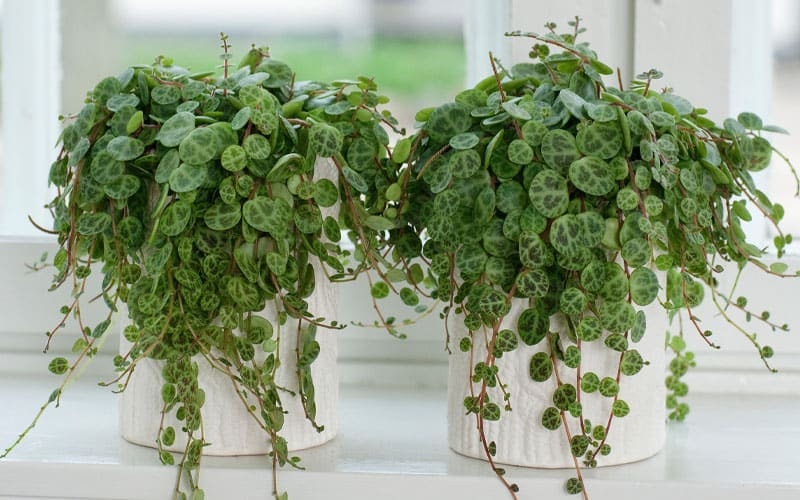Cultivating a string of turtles can enrich any indoor setting, especially for plant enthusiasts who adore interesting foliage and compact growth. These plants showcase small, patterned leaves that resemble turtle shells, hence the name. Enthusiasts often describe them as endearing and suitable for both beginner and experienced collectors.
Peperomia prostrata has risen in popularity due to its adaptability, distinctive leaf shape, and compatibility with average household conditions. In warm climates, it can even thrive outdoors, though most houseplants like these do best in controlled environments. Below is a comprehensive guide for those who wish to foster a healthy turtles plant while enjoying the botanical rewards it can bring to an indoor plant collection or other creative arrangements.
Meeting the String of Turtles - Peperomia Prostrata
Peperomia prostrata is a semi-succulent noted for its tiny leaves and delicate trailing vines. Found originally in Brazilian rainforests, this species comes from regions of high humidity, moderate temperatures, and partial shading provided by forest canopies. Many consider it a unique plant because the leaves are round and marked by light green or silvery marbling, which gives them the appearance of turtle shells. These trailing vines fit beautifully in shallow pot setups, smaller containers, or hanging baskets, making them favorites among plant enthusiasts looking to diversify a plant collection.

Peperomia prostrata adapts well to average household conditions and is considered a slow-growing species with a compact size. Whether you place it in an apartment jungle setting or a simple windowsill arrangement, it can be managed as long as its needs for indirect light, well-draining soil, and moderate humidity are met. The semi-succulent foliage holds moisture to some degree, meaning it won't require watering as frequently as some other succulents might.
Why Is the String of Turtles So Popular?
The turtle shells motif on each leaf brings an eye-catching factor that continues to capture the attention of both casual growers and master gardeners. The trailing habit also allows the vines to cascade over container edges, adding dimension to any design. Many incorporate a string of turtles into modern office decor or as a highlight in living spaces. The soft green and silver patterns offer a contrast to bolder plants, making it a suitable choice for subtle accents. Besides, contrasting itself plays a significant role in floral designs - expert Tuba Oskan shares her views on the importance of contrast.
Though not traditionally associated with large bouquets, some designers appreciate Peperomia prostrata as a filler or accent in smaller tabletop displays. When potted in shallow containers, it can be combined with other succulents or placed on coffee tables to spark curiosity among guests.

Because turtles have moderate levels of moisture, bright indirect light, and regular but not excessive watering, it suits those seeking a plant that requires mindful care yet remains relatively forgiving. Many folks also enjoy gifting new plants from stem cuttings, spreading the interest in turtles Peperomia prostrata further.
How This Plant Adds Value in Interior Decor and Floral Design
Peperomia prostrata shines as a conversation starter in interior decor because of its appealing turtle shells and light green accents. While some growers keep their string of turtles in a standalone pot, others like to incorporate it into groupings of other succulents. Its trailing habit looks appealing when placed on shelves or elevated stands, often complementing bigger species.
- Floral Design Accents: Some florists or interior designers weave short vines of the string of turtles among mini succulent soil displays or small potted compositions. The round leaves provide an unusual contrast to upright stems or thick leaves found in bigger specimens.
- Highlights in Home Settings: For those with limited space, hanging baskets of string of turtles can be a way to bring in greenery without occupying a precious tabletop room. The interplay of trailing vines with surrounding decor can be striking, especially when accompanied by bright indirect light from a nearby window.

Maintaining a healthy environment that respects the plant's needs for humidity, moderate warmth, and bright indirect light ensures that your design remains fresh over the longer term.
Understanding the Environmental Conditions to Grow String of Turtles
As a semi-succulent native to Brazil, Peperomia prostrata manages well in typical indoor settings, especially if given consistent, moderate warmth. Bright indirect light supports healthy leaf coloration, though partial shade can also be acceptable.
Routine checks on moisture and airflow around the foliage help avert stress. Many enthusiasts find that an environment free from drafts or intense midday sun is sufficient. By keeping conditions steady, you pave the way for a content and visually appealing turtles plant.

Light Requirements For Peperomia Prostrata Plants
A consistent source of bright indirect light typically suits Peperomia prostrata best. The plant can handle moderately shaded pots, though an extremely dark area could encourage a slow growth rate or leggy vines. If the only windows you have receive intense direct sunlight, consider placing a sheer curtain or moving the pot a few feet away from the window to protect the delicate leaves.
Some growers supplement with artificial light to help maintain healthy patterns in the foliage, especially during winter months. Ensuring that your plant receives enough brightness without subjecting it to harsh direct sun is key to preserving its turtle shell markings.

Temperature and Humidity Needs for String of Turtles Plant
Since these plants originated in Brazilian rainforests, they enjoy a consistent temperature in the range of 16-24°C (60-75°F). Extremely cold temperatures could hamper growth or cause leaf drop. A small humidifier or a tray of water placed closely can raise humidity levels if your home is especially dry. The target humidity levels for optimal foliage often sit between 40% and 50%.
Keep in mind that semi-succulent leaves still benefit from a stable environment; large swings in warmth or moisture can stress the plant. Observing these factors, plus avoiding direct sunlight at midday, can preserve the plant's color patterns.
Watering and Soil Essentials - Proper Watering Techniques
The key to maintaining a robust string of turtles is balancing moisture and aeration. Although Peperomia prostrata leaves can hold some water, they do not tolerate being waterlogged. Many new growers notice that overwatering is a major trigger for root rot in these plants. The ideal practice is to let the top inch of soil dry before watering again. Testing the soil's dry level with your fingertip is a reliable tactic to avoid flooding the pot.

- Seasonal Adjustments: During the cooler periods of the year, the plant's internal processes slow down, reducing water needs. Turtles prefer less frequent watering then, but still require attention so the soil does not become entirely desiccated.
- Monitoring Soil Moisture: Maintaining an appropriate watering schedule ensures that the soil's moist threshold is respected without drowning the fine roots.
Choosing a Well-Draining Soil Mix For Your String of Turtles Plant
Building or building a suitable potting mix can make the difference between a thriving specimen and a struggling one. A succulent soil blend or well-draining base that uses peat moss, coarse sand, and perlite is a solid choice.
Mixing in organic matter can help keep nutrients available while still allowing water to drain off quickly. Because Peperomia prostrata has shallow, fine roots, heavy or compacted soil can lead to rot. By choosing the right potting mix, you can ensure proper drainage and maintain a consistently airy environment that supports growth throughout the growing season.
Potting and Repotting - Selecting the Right Container
Picking the correct pot and layout is central to supporting healthy turtles Peperomia prostrata. Too large a container holds excess moisture and hampers the root system. Opting for a shallow pot can be beneficial, especially since these plants naturally have a shallow root zone. When deciding on a container, keep a close eye on the presence of drainage holes. Many individuals enjoy placing them in decorative planters, but the fundamental design should let extra water escape to reduce plant diseases.

- Drainage Holes: Providing a way for water to run off helps avoid waterlogged soil that leads to fungal issues or root rot.
- Shallow Pot: The plant's small root system does best when it is not overwhelmed by too much soil volume.
Repotting Timeline
While Peperomia prostrata exhibits a slow-growing pattern, there will come a time when it needs an upgrade. A suitable interval might be every two or three years. Keep watch for signs like roots poking through the pot's drainage holes or stunted leaves.
When repotting a string of turtles, gently loosen the soil around the roots and lift the entire plant out. Transfer to a new container that is only slightly larger than the previous one. Patience is crucial, as abrupt changes to the environment or pot size can shock the plant and stall future development.

Propagation and Pruning Your Peperomia Plants
Plant enthusiasts often find joy in propagating string of turtles. The process tends to be straightforward and highly rewarding. In many cases, even small clippings can yield new plants when handled properly.
- Stem Cuttings: Cut small segments, preferably including a few leaves attached at the nodes. Place these cuttings either in a jar of water or directly in a potting mix that encourages root formation.
- Division: If you have a mature cluster, you can gently separate it into sections to start multiple smaller pots.
Pruning these plants mostly involves removing damaged leaves and maintaining a balanced form.
Pruning Tips for Your Peperomia Prostrata
Although not always mandatory, pruning helps keep the growth neat. Removing dead foliage prevents decay, and trimming overly long vines can enhance air circulation around the leaves. Using clean scissors reduces the risk of transmitting bacteria. If you do trim aggressively, expect a few weeks of slower recovery before the plant regains vigor. Considering Peperomia prostrata's slow growth rate, moderate pruning goes a long way without setting the plant back too much.

Pest Control and Disease Prevention - Common Pests
While a string of turtles is generally not prone to severe pest outbreaks, it can still fall victim to common pests such as mealybugs, fungus gnats, and spider mites. These insects often feed on the tender stems or underside of leaves. Inspecting the foliage frequently helps detect unwanted visitors at an early stage. Neem oil sprays and insecticide soap can be applied to infected areas.
The key is to avoid overwatering, keep leaves clean, and ensure consistent temperature to create an inhospitable environment for bugs.
Disease Prevention in Peperomia Plants
Problems like root rot often happen when the soil is constantly wet. A well-draining approach with organic matter in the potting mix can deter fungal growth. Another component of disease management is cleaning out older leaves that have fallen into the pot since decaying material can harbor pathogens. Circulation around the leaves, combined with partial shade from direct sun, contributes to a stable environment that reduces plant diseases.

Encouraging Healthy Growth and Bloom in String of Turtles - Best Fertilization Practices
Peperomia prostrata can produce small, inconspicuous flowers during the growing season, though many growers focus on their leaf shape and trailing habit rather than blooms. Nonetheless, feeding a turtles Peperomia prostrata with a balanced houseplant blend at half strength can promote robust foliage. Aim for monthly or bimonthly fertilizing routines in spring and summer.
- Seasonal Timing: Spring and summer mark the growing season, so that is when you want to feed more frequently.
- Slow Dose: Because the plant is not a heavy feeder, applying fertilizer at half strength helps prevent burning sensitive roots.
- Avoid Overwatering: Along with moderate fertilization, be mindful that saturating the soil with water plus fertilizer can cause stress for Peperomia prostrata.
Flowering Patterns in String of Turtles Plant
Under stable conditions, including bright indirect light and appropriate watering, Peperomia prostrata may send up small flower spikes. These are usually white or pale green, sprouting from the vine. Some collectors enjoy seeking these modest flowers, although they are more of a visual curiosity than a grand display. Consistency in humidity levels, minimal fluctuations in temperature, and providing a healthy potting mix all encourage potential blossoms during the warmer months.

A string of turtles is a delightful piece for plant enthusiasts, novices, and even a master gardener eager to expand a collection. Although it has a slow-growing habit, it rewards care with intricate patterns, semi-succulent leaves, and the option to share cuttings with friends.
While some treat Peperomia prostrata purely as a decorative accent, others see it as part of a larger indoor plant collection that highlights unique forms and textures. Offering it a shallow pot with drainage holes, a well-draining potting mix, and a stable watering schedule will encourage it to flourish. Over time, you may find it reaches full maturity in three to five years, providing an ongoing source of enjoyment.
The satisfaction in nurturing these turtles stems from knowing how to balance moisture, light, and soil conditions. If you maintain bright indirect light, keep watering intervals in check, and guard against root rot, your arrangement can thrive for many seasons.




